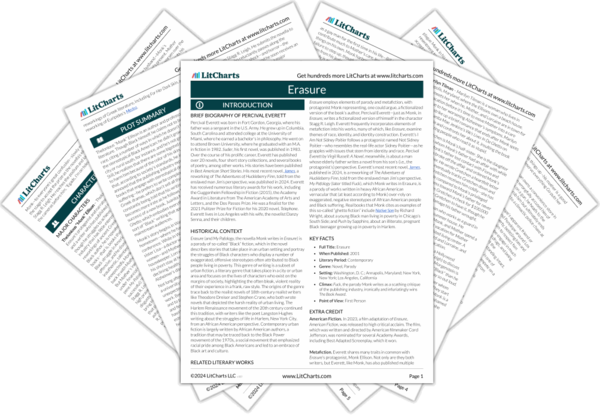In Erasure, woodworking, a hobby of Monk’s, symbolizes the certainty and clarity Monk desires—and yet so infrequently achieves—in his professional pursuits, his relationships, and his sense of self. As a writer, Monk is used to the slippery, fluid quality of written and spoken language, which can strike a person differently based on a number of factors, from circumstance, to experience, to expectations. The same language that creates a feeling of unity among some people can alienate others. For instance, Monk recalls the intense “awkwardness” he felt as a child when he struggled to use African American vernacular in a way that felt and sounded natural.
Woodworking, by contrast, is about concrete surfaces—and because of this, there is considerably less room for interpretation, misinterpretation, and error. “Damnit, a table was a table was a table,” Monk declares at one point in the novel, describing the clear and unambiguous final result of any given woodworking project. But the same cannot be said for Monk’s novels, which rarely receive the feedback Monk desires. Publishers disregard Monk’s serious novels for their failure to reflect consciously on race—a genre convention the publishing industry more or less requires of the works by Black writers it deigns to publish at all. Meanwhile My Pafology, the caustic work of satire Monk pens as an attack on the publishing industry, is grossly misinterpreted, with publishers and critics alike failing to grasp its unserious tone and instead interpreting as a genuine representation of Black life, and then using that interpretation to reaffirm their own assumptions and prejudices about Black people and race as a whole. For Monk, woodworking functions as a necessary escape from the burdensome, frustrating, and sometimes painful situations that tend to arise arise once fluid, finicky language is involved.
Woodworking Quotes in Erasure
I tried to distance myself from the position where the newly sold piece-of-shit novel had placed me vis-à-vis my art. It was not exactly the case that I had sold out, but I was not, apparently, going to turn away the check. I considered my woodworking and why I did it. In my writing my instinct was to defy form, but I very much sought in defying it to affirm it, an irony that was difficult enough to articulate, much less defend. But the wood, the feel of it, the smell of it, the weight of it. It was so much more real than words. The wood was so simple. Damnit, a table was a table was a table.

Unlock explanations and citation info for this and every other Erasure quote.
Plus so much more...
Get LitCharts A+









